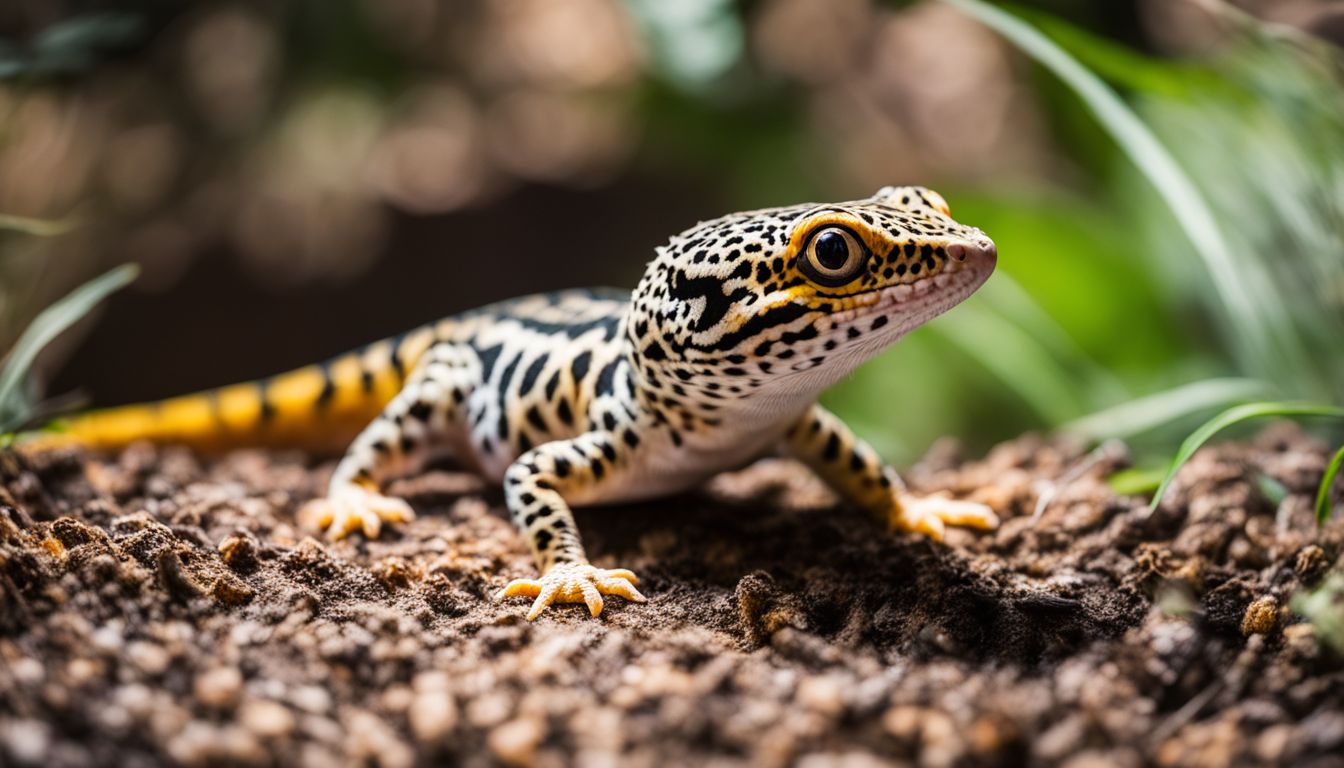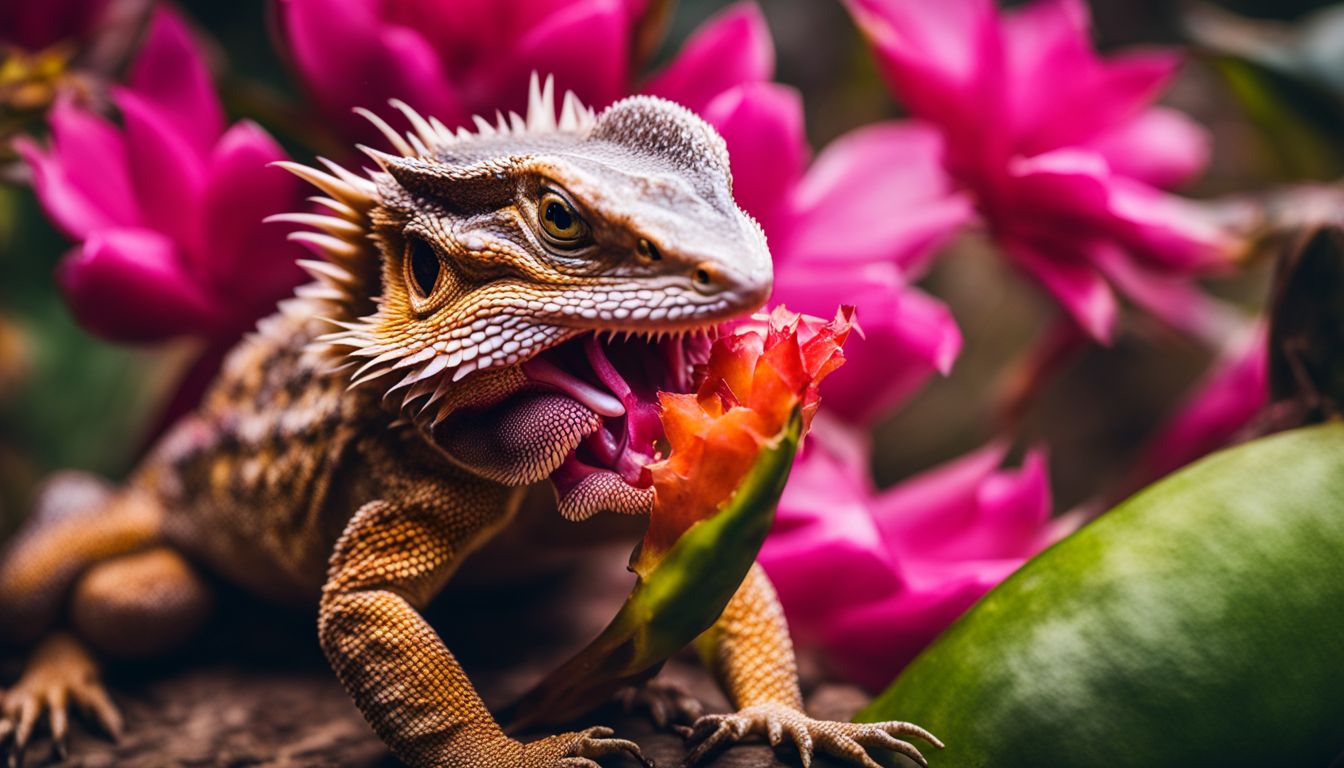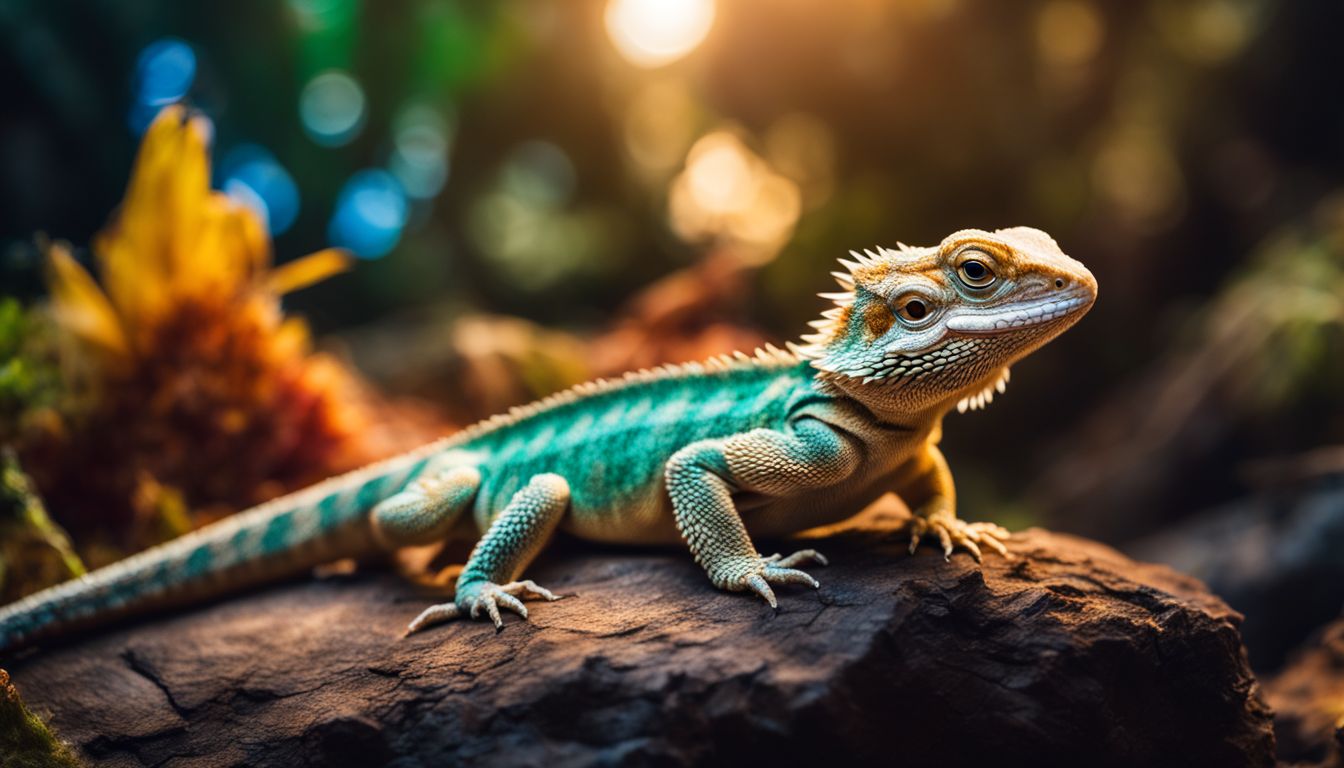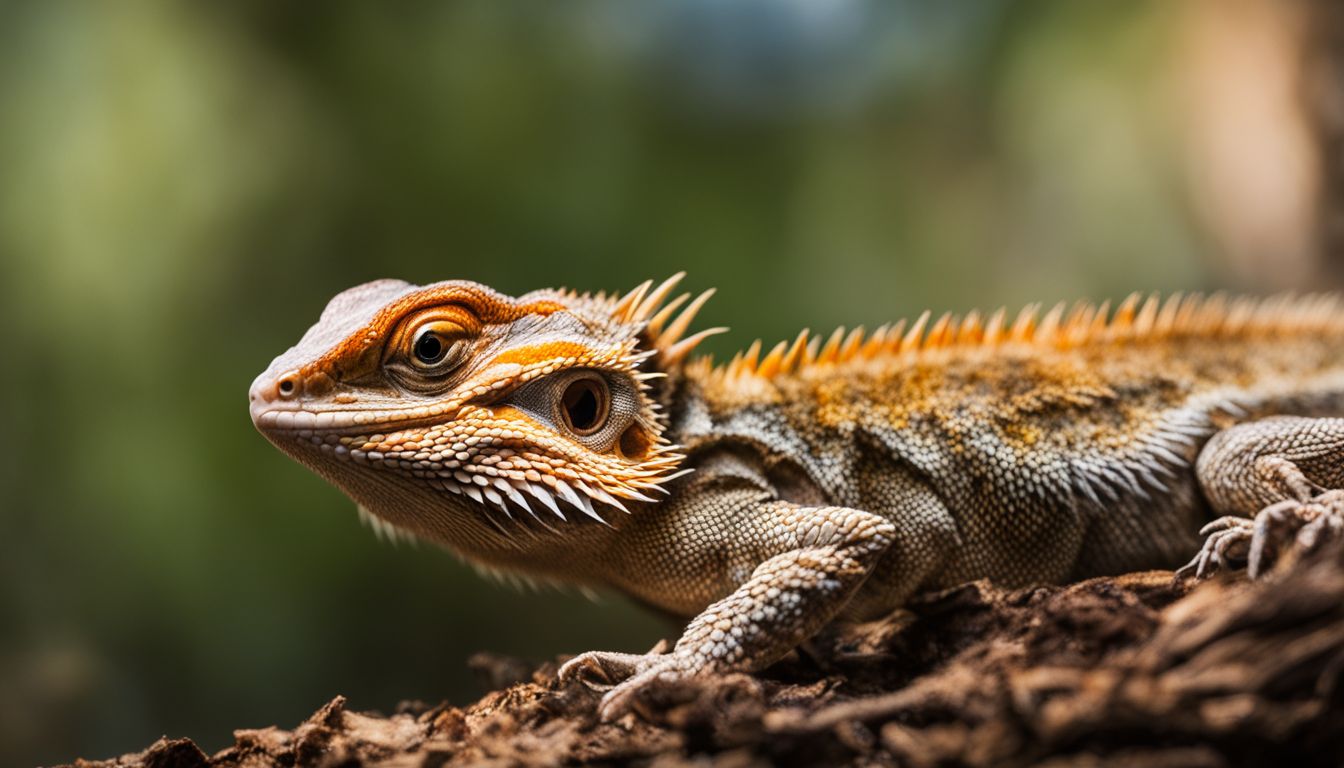Are you a proud owner of a leopard gecko and wondering if your scaly friend could join you for some fresh air outside? You’re not alone! Many reptile enthusiasts are curious about sharing the joy of the great outdoors with their pet.
While leopard geckos thrive indoors, stepping out can be an exciting change for them and you. However, outdoor escapades come with unique challenges that need your careful attention to keep your little buddy safe.
Did you know leopard geckos can live up to 20 years when cared for properly? That’s plenty of time to create countless memories, including some under the sun! This guide will walk you through everything from assessing weather conditions to recognizing stress signals in your gecko.
We’ll make sure you’re equipped with all the right info so both of you can safely enjoy those sunny days together. Get ready to unlock a new level of fun with your leopard gecko!
Key Takeaways
- Leopard geckos are small, colorful lizards that can live up to 20 years if well taken care of. They enjoy warm environments but are sensitive to extreme temperatures. When taking them outside, it’s crucial to monitor the weather conditions and provide a safe outdoor space.
- Before venturing outdoors, assess the weather to ensure it’s not too hot or cold for your gecko. Aim for sunny days with temperatures between 70-85 degrees Fahrenheit and no rain or strong winds forecasted.
- To create a safe outdoor environment, use a secure enclosure with suitable temperature and humidity levels. Always supervise your gecko closely, recognize stress signals, and acclimate them gradually to their new surroundings.
- Using a reptile leash provides safety during outdoor adventures; choose the right time of day when the sun is less intense to prevent overheating. Recognize stress signals such as tail waving or rapid breathing to ensure your leopard gecko feels comfortable and secure while enjoying outdoor activities.
Understanding Your Leopard Gecko’s Needs

Leopard geckos are naturally found in the dry, rocky regions of Pakistan, Afghanistan, and India. They require warm temperatures and access to a hiding place for security. Outdoor time can provide enrichment but also poses risks such as predation and stress.
The Nature of Leopard Geckos
Leopard geckos are small, colorful lizards loved by many pet owners. They come from dry, rocky places and like to hide during the day. At night, they come out to hunt for food. These geckos can grow up to 10 inches long and live around 20 years if well taken care of.
They have a gentle nature and don’t need as much attention as other lizards, making them great for beginners.
These little creatures enjoy warm environments but too much heat can harm them. Their bodies are made for cool nights and not very hot days. So when taking them outside, it’s important to keep an eye on the temperature to make sure they’re comfy.
Ready for some fresh air? Let’s get your leopard gecko ready for a safe trip outdoors!
Risks and Benefits of Outdoor Time
Taking your leopard gecko outside can be a great way to give them a taste of their natural environment and some warm sunlight. Sunlight is good for these little reptiles as it helps them make vitamin D3, which they need for healthy bones.
But you must watch the temperature closely, because if it gets too hot or cold, your gecko could get sick. Make sure there’s always a shady spot where they can cool off.
There are risks to think about before heading out. Predators like birds and other animals could hurt your pet, so an outdoor enclosure is important to keep them safe. Also, be careful with things around the yard like toxic plants or chemicals that might harm your gecko if they touch or eat them.
Always stay with your pet to keep an eye on any danger and to see how they’re doing.
Next up is making sure you’re all set for going outdoors safely!
Preparing for the Outdoors

Assess the weather conditions before taking your leopard gecko outside to ensure it’s not too hot or cold. Create a safe outdoor environment with proper temperature regulation and secure enclosures for your gecko.
Assessing the Weather Conditions
Before taking your leopard gecko outside, check the weather. These reptiles need warmth, so it’s best when it’s sunny and the temperature is between 70-85 degrees Fahrenheit. Too hot or too cold can hurt them.
Make sure there’s no rain or strong winds forecasted.
Next, create a safe outdoor space for your leopard gecko to explore without any risks.
Creating a Safe Outdoor Environment
When creating a safe outdoor environment for your leopard gecko, consider using a secure enclosure to prevent escape or harm from potential predators. Ensure the temperature and humidity levels are suitable, and provide hiding spots and non-toxic plants for your pet’s comfort and safety.
Always supervise your leopard gecko closely when outdoors to prevent any accidental injuries or mishaps, ensuring they have an enriching experience while being protected.
Moving on to “Best Practices for Outdoor Adventures,” let’s explore how to make the most of your time outside with your leopard gecko.
Acclimating Your Gecko Gradually
Your leopard gecko needs time to adjust to the new environment outside. Start with short outings and gradually increase the duration. This will help them adapt to the changes in temperature, light, and sounds.
Use this opportunity to observe their behavior and ensure they are comfortable before extending their outdoor time. Remember, a gradual approach is key to helping your gecko feel secure and safe outdoors.
Next up, we’ll learn about best practices for outdoor adventures with your leopard gecko.
Best Practices for Outdoor Adventures
When taking your leopard gecko outside, it’s important to use a reptile leash for safety and choose the right time of day for outdoor adventures. Supervising your gecko closely and recognizing stress signals are also essential for their well-being.
Using a Reptile Leash for Safety
When taking your leopard gecko outside, using a reptile leash provides an extra layer of safety. The leash helps prevent your gecko from darting away and getting lost or injured. It allows you to give them some freedom while still being able to supervise their outdoor exploration.
Additionally, it’s important to choose a lightweight and comfortable leash specifically designed for reptiles like leopard geckos to ensure their comfort and safety.
Next, let’s delve into the importance of choosing the right time of day for your outdoor adventures with your leopard gecko.
Choosing the Right Time of Day
Leopard geckos should be taken outside during early morning or late afternoon when the sun is less intense. This helps to avoid overheating and ensures a comfortable outdoor experience for your pet.
When the temperatures are moderate, it’s safer for them to explore their surroundings without the risk of getting too hot or stressed.
To ensure a pleasant outing, assessing weather conditions and choosing the right time of day plays a crucial role in providing an enjoyable outdoor adventure for your leopard gecko.
Supervising Your Leopard Gecko
When supervising your leopard gecko outdoors, always stay close to ensure their safety. Keep an eye out for any signs of stress or discomfort while they explore. It’s crucial to have them on a leash or in a secure enclosure at all times to prevent escape or potential harm from predators.
By staying vigilant and offering reassurance, you can make the outdoor experience enjoyable for both you and your leopard gecko.
Moving on to “Recognizing Stress Signals” – this will help you understand your pet’s needs better and provide a safe outdoor environment that caters to their well-being.
Recognizing Stress Signals
As you supervise your leopard gecko during outdoor adventures, it’s essential to be aware of stress signals. Leopard geckos may display signs of stress, such as tail waving, hiding, or loss of appetite.
They might also exhibit rapid breathing, excessive licking, or a darkened coloration. If you notice these behaviors in your pet, it’s crucial to move them to a quieter and more familiar environment to help reduce their stress levels.
Recognizing and responding to these signs promptly can contribute to your leopard gecko feeling more secure and comfortable during outdoor activities.
By paying attention to the stress signals mentioned above while supervising your leopard gecko outdoors, you can ensure their well-being and create a positive outdoor experience for them.
Conclusion
In conclusion, taking your leopard gecko outside can be a rewarding experience when done with proper care and preparation. By following the practical tips provided in this guide, you can ensure a safe and enjoyable outdoor adventure for your pet.
Have you considered how these strategies could enhance your leopard gecko’s well-being? Remember, creating a secure outdoor environment for your leopard gecko is essential to their happiness and health.
With the right approach, you can make outdoor time a beneficial and enriching experience for both you and your leopard gecko.
)
When taking your leopard gecko outside, it’s important to understand their needs and risks. Leopard geckos can live up to 20 years and grow as long as 10 inches, making them popular beginner reptiles because they are easy to handle and require minimal care.
However, when bringing them outdoors, consider factors like temperature, humidity, potential predators, and safe enclosures.
Taking a leopard gecko outside should be done with proper precautions and under close supervision. Avoid toxic plants and pesticides in the outdoor environment; provide limited sun exposure to prevent overheating; use a reptile leash for safety; choose the right time of day for outdoor adventures; recognize stress signals; acclimate gradually; assess weather conditions before going out.
By following these best practices, you can safely enjoy the great outdoors with your pet leopard gecko while promoting their overall well-being and happiness.
While exploring outdoor activities for your leopard gecko, you might also be curious about the costs associated with other reptile pets; find out more about gargoyle gecko expenses.
FAQs
1. Can I safely take my leopard gecko outside?
Yes, you can take your leopard gecko outside as long as you ensure the outdoor environment is safe, free from predators and extreme temperatures, and always supervise them.
2. What are the potential risks of taking my leopard gecko outdoors?
The potential risks of taking your leopard gecko outside include exposure to parasites, diseases from wild reptiles, stress from unfamiliar surroundings, and possible escape.
3. How much time can my leopard gecko spend outdoors?
It’s recommended to limit outdoor time for your leopard gecko to 15-20 minutes per session to prevent them from becoming overwhelmed or affected by temperature changes.
4. Do I need any special equipment when taking my leopard gecko outside?
When taking your leopard gecko outside, make sure to use a secure and escape-proof container such as a small carrier or a harness specifically designed for reptiles.
5. Is there anything specific I should look out for when bringing my Leopard Gecko back indoors after being outdoors?
After being outdoors, check for any signs of stress or health issues in your Leopard Gecko such as lethargy or loss of appetite and provide a familiar and comfortable environment upon returning indoors.




